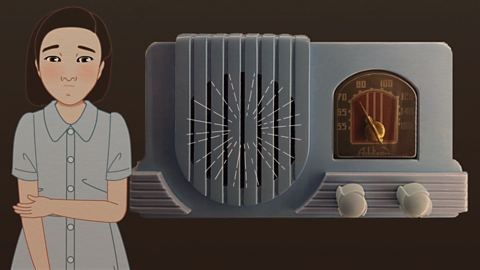Key points
Britain declared war on Germany on 3 September 1939.
The war ended in 1945. Germany surrendered in May and their ally, Japan, surrendered in September.
The war involved the worldās major powers, including Britain, France, Russia, the USA, China and Japan. This guide looks at some of the key events of World War Two.
Who fought during World War Two?
World War Two was a global conflict that involved most of the worldās countries. These countries formed two opposing military allianceA union or association formed between countries or organisations., which fought against each other throughout the war. These alliances were known as the Allies and the Axis powers.
The main members of these alliances are listed in the table:
| Allies | Axis |
|---|---|
| United Kingdom | Germany |
| USA | Italy |
| Soviet Union | Japan |
Key events of World War Two
The Phoney War
Although Britain declared war on Germany on 3 September 1939, there was only a small amount of fighting. The SS Athenia, a British ship, was sunk by a German U-boat while transporting evacuees to Canada. France made a small-scale attempt to attack Germany through the Saar region, but this was soon abandoned. This period of time is often referred to as the āPhoney Warā.
People in Britain had expected bombing and fighting to start straight away, but it did not. The āPhoney Warā ended in April 1940, when Germany invaded Norway. Britain took military action to try and support Norway against Hitlerās invasion, but they failed. This failure was debated by MPMember of Parliament- a politician who represents a particular area of the country, known as a constituency, and votes on laws. in the House of Commons shortly after. Prime Minister Neville Chamberlain was strongly criticised for the failure during the debate. He was unable to form a government that would support him, so he had to resign. He was replaced by Winston Churchill in May 1940.
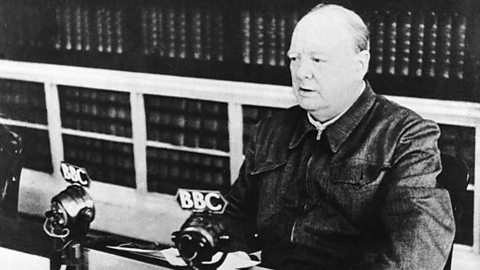
1940: Blitzkrieg and Dunkirk
The German army was sweeping through Europe. Their tactics were known as āBlitzkriegā, which means ālightning warā. They quickly overwhelmed the defences and armed forces of countries they invaded.
On 10 May 1940, the German army entered France. They swept through the country, capturing Paris on 14 June. The British Expeditionary ForceThe units of the British army sent to France at the start of World War Two to try and protect them from German invasion., which had been sent to France to try and stop the German invasion, had to retreat. They reached the English Channel and waited on beaches at Dunkirk to be rescued.
Britain had soldiers fighting from many different countries in its empire. For instance, Major Mohammad Akbar Khan, an Indian soldier, was in charge of 300 Indian soldiers and 23 British troops. He led them through Dunkirkās heavily bombed harbour. To find out more about the role of troops from across the British Empire during World War Two, read this guide.
Britain organised a huge evacuation effort, sending over a whole range of naval and civilian boats to pick up stranded soldiers. Dutch, Belgian, French and Norwegian ships were also involved in the operation. The evacuation was considered to be a success, with 340,000 French and British soldiers brought back to England in one week. However, there were also big losses: over 68,000 soldiers were killed, wounded, captured or unaccounted for. Over 400 tanks, six destroyerA naval warship, usually used to accompany larger ships on a mission. and 145 aircraft were also lost. These losses were hugely damaging to the war effort.
The evacuation of Dunkirk also meant Britain was left to fight against Germany without France, one of its key allies. Churchill privately called Dunkirk āa colossal military disasterā, which showed his concern about the loss of men and equipment.
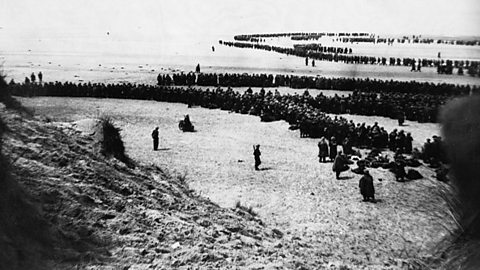
The German air force, the Luftwaffe, fought against the British RAF from July to October 1940, in the Battle of Britain. The RAF were victorious, meaning Germany had to change their tactics to try and invade Britain.
1941 - 1943
Despite signing the Nazi-Soviet Pact in 1939, Germany invaded the Soviet Union in June 1941. This was codenamed Operation Barbarossa. This meant Germany was now fighting a war on two fronts, against Britain in the west and the Soviet Union in the east.
Operation Barbarossa failed. There were mistakes in planning and tactics which meant Germany couldnāt take advantage of early successes. The winter in the Soviet Union also made it difficult. Fuel froze in German tanks and vehicles, and German soldiers froze to death as they werenāt given enough winter clothing.
There were many casualties. Germany suffered over 1 million, while the Soviet Union had almost 5 million.
What happened at Pearl Harbor?
The USA had officially remained neutral when World War Two broke out. However, American President Franklin Roosevelt was keen to provide support to Britain. On 7 December 1941, a Sunday morning, Japan carried out a surprise attack on the American Naval base at Pearl Harbor, in Hawaii.
The bombing followed several years of rising tension between Japan and the USA. The USA had imposed economic sanctions on Japan, which affected trade in goods such as oil and aircraft, and prevented Japan from becoming a bigger global power. Moreover, the USA did not expect Japan to attack them in Hawaii, which meant that they had relatively few defences in place at Pearl Harbor. Japan took advantage of this in the knowledge that, if they could destroy the base, it would mean that they could have control of the Pacific.
The attack killed 2,335 American troops and damaged or destroyed 21 US Navy ships. On 8 December, Roosevelt spoke to Congress and declared war on Japan and Germany. This was one of the turning points in the war, resulting in American troops and supplies joining the war in Europe to support Britain.
1943 - 1945: Europe
The support of American forces was crucial for Britain. By early 1944, plans were being made to return to France to try and push Germany back. British, American and Canadian troops planned to land on beaches in Normandy with the aim of liberating France from German occupation. To try and deceive Germany, hundreds of fake wooden planes were built and placed near Dover, to convince German pilots flying over Britain that an invasion was going to take place at Calais. This plan was effective in helping troops land at Normandy with less resistance.
The landings took place on 6 June 1944. This was known as D-Day. 160,000 troops landed on the Normandy beaches; over 4,000 lost their lives. The invasion was a success, and German forces were driven back. This was a key moment in the war and turned it in the Alliesā favour.
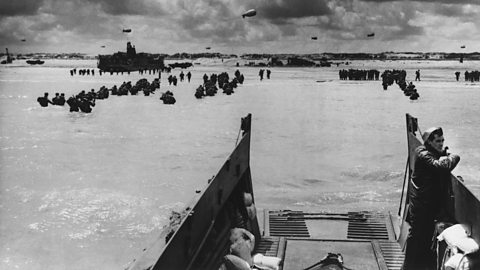
Following the D-Day landings, Allied troops began to push Germany back from the west. At the same time, Soviet troops were advancing towards Germany from the east. By February 1945, the Allies were confident enough of victory that they met at Yalta to discuss how to rebuild Europe and recover from the effects of war.
In April 1945, Allied troops entered Berlin. Hitler, realising that defeat was now inevitable, died by suicide on 12 April. Germany surrendered on 8 May. This is known as VE Day (Victory in Europe Day).
Hiroshima and Nagasaki
While Germany had surrendered, the Pacific WarThe battles of World War Two that were fought in Asia, the Pacific Ocean, the Indian Ocean and Oceania. Geographically, the Pacific War was the largest area of fighting of World War Two. It included Japan and the Philippines.continued. One of the most significant events of World War Two happened in 1945. This was the dropping of atom bombA nuclear weapon that releases a huge amount of energy by splitting atoms. They can cause enormous amounts of death and damage when dropped on an area. on the Japanese cities of Hiroshima and Nagasaki by American forces.
An atom bomb is capable of causing much greater destruction than the bombs that had been used throughout World War Two, and in previous conflicts. The dropping of the atom bombs was the first and only time that nuclear weaponAn extremely powerful explosive device that gets its energy from nuclear reactions. Nuclear weapons are much more powerful than even the largest non-nuclear bomb. Their explosions are so powerful that just one nuclear weapon is capable of completely destroying a city. Nuclear weapons also release huge amounts of radiation, which causes terrible illnesses for a very long time after the initial explosion. have been used.
The decision to drop the atom bomb was taken by President Harry S. Truman, who had replaced Franklin Roosevelt following his death in April 1945. On 6 August 1945, Truman ordered an atom bomb to be dropped on the city of Hiroshima. It was dropped by a bomber plane named the Enola Gay. It is thought that at least 140,000 people were killed, of a total population of around 350,000.
When the atom bomb was dropped:
- It exploded with the force of 20,000 tons of TNTAn explosive material commonly used in bombs..
- The temperature at the centre of the explosion reached 3000ĀŗC - 4000ĀŗC ā three times hotter than volcanic lava.
- Everything within a mile of the centre of the blast was flattened.
- Fires spread and around 67 per cent of Hiroshimaās buildings were destroyed.
Three days after the atom bomb was dropped on Hiroshima, a second one was dropped on the city of Nagasaki by a bomber plane called Bockscar. A further 74,000 people, at least, were killed. The Japanese Emperor, Hirohito, announced that Japan would surrender on 15 August. They formally signed a surrender agreement on 2 September.
This brought World War Two to an end.
Why did President Truman decide to use the atom bomb?
Historians believe that there were several reasons for Trumanās decision to drop atom bombs on Japanese cities.
One of these was that the USA had been involved in a bombing campaign against Japan since 1942, which had not enabled them to achieve their military aims. In the last seven months of this campaign, American forces had tried āfire bombingā. This involved causing damage to an area using fire, set off by highly flammable devices, rather than the blast effect of a bomb. This was instead of using precision bombing, which usually targeted more specific areas, such as a particular building. Fire bombing had killed up to 500,000 people, destroyed 67 Japanese cities and left 5 million people homeless.
In July 1945, the Pacific War had been moving very slowly. There was a lot of fighting between the Allies and Japan. Japan was preparing to fight an invasion from the Allies, and they were gathering millions of troops to do this. The USA was worried that invading Japan could result in millions of American casualties, and make the war last even longer. Truman said that dropping the atom bomb would bring the war to a quicker end, and therefore save the lives of American soldiers.
Some historians have also suggested that Truman was worried that the communist Soviet Union might want more influence in Japan and its surrounding countries. Others believe that Truman decided to drop the atom bombs as a big show of āstrengthā, to show the Soviet Union that the USA was very powerful.
Consequences of the atom bomb
The consequences of the atomic bombing of Hiroshima and Nagasaki were huge:
- Hundreds of thousands of people were killed, while lots more suffered terrible injuries.
- Many people who survived the dropping of the atom bombs suffered from poor health, caused by exposure to radiation in the aftermath of the bombs. In Japanese, the survivors of the atom bomb are known as āh¾±²ś²¹°ģ³Ü²õ³ó²¹ā.
- By the 1950s, the USA and the Soviet Union had developed an even more powerful weapon, known as the hydrogen bombAn extremely powerful nuclear weapon, capable of causing even more destruction than the atom bombs used during World War Two. It works by releasing a huge amount of energy, like an atom bomb. This explosion causes the heating of hydrogen, which starts a series of further nuclear reactions.. This could cause even more destruction than the atom bombs that were dropped on Hiroshima and Nagasaki.
The dropping of the atom bombs on Japan was a globally significant event. Many historians believe that it changed the world forever. This is because it led to the development of even more powerful weapons and because it had a huge impact on relationships between countries.
After World War Two, there was a lot of tension between the USA and the Soviet Union, but they did not start a war with one another because both countries had nuclear weapons. Both countries knew that, if they used nuclear weapons, entire countries could be destroyed, and millions of people would be killed. For many years, people lived with great fear that there could be a nuclear war. This period of tension was known as the Cold War.
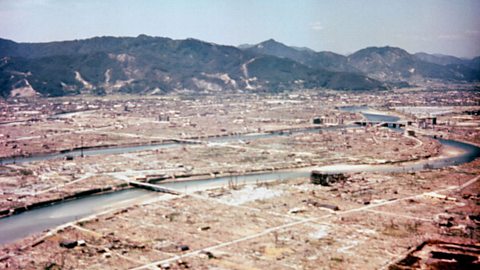
Test your knowledge
Play the History Detectives game! gamePlay the History Detectives game!
Analyse and evaluate evidence to uncover some of historyās burning questions in this game.

More on World War Two and the Holocaust
Find out more by working through a topic
- count3 of 10
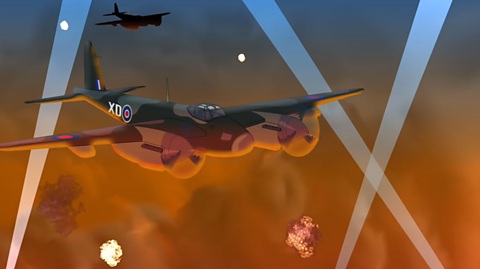
- count4 of 10

- count5 of 10
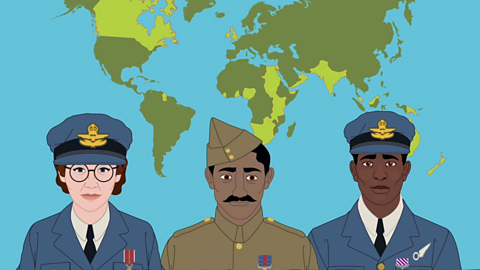
- count6 of 10
